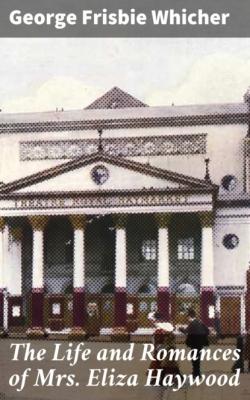ТОП просматриваемых книг сайта:
The Life and Romances of Mrs. Eliza Haywood. George Frisbie Whicher
Читать онлайн.Название The Life and Romances of Mrs. Eliza Haywood
Год выпуска 0
isbn 4064066165086
Автор произведения George Frisbie Whicher
Жанр Языкознание
Издательство Bookwire
George Frisbie Whicher
The Life and Romances of Mrs. Eliza Haywood
Published by Good Press, 2019
EAN 4064066165086
Table of Contents
THE LIFE AND ROMANCES OF MRS. ELIZA HAYWOOD
PREFACE
The purpose of the following study is not to revive the reputation of a forgotten author or to suggest that Mrs. Haywood may yet "come into her own." For the lover of eighteenth century fashions her numerous pages have indeed a stilted, early Georgian charm, but with the passing of Ramillies wigs and velveteen small-clothes the popularity of her novels vanished once for all. She had her world in her time, but that world and time disappeared with the French Revolution [a]. Now even professed students of the novel shrink from reading many of her seventy odd volumes, nor can the infamous celebrity conferred by Pope's attack in "The Dunciad" save her name from oblivion. But the significance of Mrs. Haywood's contributions cannot safely be ignored. Her romances of palpitating passion written between 1720 and 1730 formed a necessary complement to Defoe's romances of adventure exactly as her Duncan Campbell pamphlets supplied the one element lacking in his. The domestic novels of her later life foreshadowed the work of Miss Burney and Miss Austen, while her career as a woman of letters helped to open a new profession to her sex. Since even the weakest link in the development of a literary form is important, I have endeavored to provide future historians of English fiction with a compact and accurate account of this pioneer "lady novelist."
Hitherto the most complete summary of Mrs. Haywood's life and writings has been Sir Sidney Lee's article in the "Dictionary of National Biography," which adds much information not found in the earlier notices in Baker's "Biographia Dramatica" and Chalmers' "Biographical Dictionary." The experienced palates of Mr. Edmund Gosse and Mr. Austin Dobson have tested the literary qualities respectively of the earlier and later aspects of her work. Professor Walter Raleigh, Dr. Charlotte E. Morgan, and Professor Saintsbury have briefly estimated the importance of her share in the change from romance to novel.
Perhaps the main reason for the inadequacy of these notices lies in the fact that no one library contains anything like a complete collection of Mrs. Haywood's innumerable books. In pursuit of odd items I have ransacked the British Museum, the Bodleian, and several minor literary museums in England, and in America the libraries of Columbia, Harvard, Yale, and Brown Universities, the Peabody Institute, and the University of Chicago. The search has enabled me to correct many inaccuracies in Miss Morgan's tentative list of prose fiction and even to supplement Mr. Esdaile's admirable "List of English Tales and Prose Romances printed before 1740," which mentions only works now extant in British libraries.
In the Bibliography I have adopted an alphabetical arrangement as most convenient for ready reference. Under the various editions of each book I have referred to libraries, English or American, where copies are to be found. Or when no copy was to be had, I have referred to advertisements, either in the newspapers of the Burney Collection, in the "Gentleman's Magazine," the "Monthly," or the "Critical," or in the catalogues of modern booksellers. In the Chronological List I have dated each work from the earliest advertisement of its publication.
Naturally I have incurred obligations to scholars who have previously passed over the same little-cultivated territory. Mr. Arundell Esdaile of the British Museum staff both facilitated the course of my investigations in England by valuable suggestions and cheered it by his cordial hospitality. To Professors R.P. Utter of Amherst, J.M. Clapp of Lake Forest College, A.H. Upham of Miami University, and A.H. Thorndike of Columbia I am indebted for friendly advice, encouragement, and helpful criticism. And above all my thanks are due to Professor W.P. Trent, whose love of eighteenth century letters suggested the subject of this research, whose sage and kindly supervision fostered the work through every stage in its development, and for whose forthcoming "Life and Times of Daniel Defoe" this monograph is intended as a footnote.
G.F.W.
URBANA, ILLINOIS.
[a] Through the kindness of Professor J.M. Clapp I am provided with the following evidence of the decline of Eliza Haywood's popularity. In W. Bent's General Catalogue of Books (1786) fourteen of her productions are advertised, namely: Works, 4 vols; Clementina; Dalinda; Epistles for the Ladies; La Belle Assemblée; Female Spectator; Fortunate Foundlings; Fruitless Enquiry; Jemmy and Jenny Jessamy; Betsy Thoughtless; The Husband; Invisible Spy; Life's Progress through the Passions; Virtuous Villager. In 1791 only four—Clementina; Dalinda; Female Spectator; Jemmy and Jenny Jessamy—appeared in Bent's London Catalogue, and of these the first two had fallen in value from 3/6 to 3 shillings.
I. ELIZA HAYWOOD'S LIFE
II. SHORT ROMANCES OF PASSION
III. THE DUNCAN CAMPBELL PAMPHLETS
IV. SECRET HISTORIES AND SCANDAL NOVELS
V. THE HEROINE OF "THE DUNCIAD"
VI. LETTERS AND ESSAYS
VII. LATER FICTION: THE DOMESTIC NOVEL
VIII. CONCLUSION
BIBLIOGRAPHY
CHRONOLOGICAL LIST
INDEX
THE LIFE AND ROMANCES OF MRS. ELIZA HAYWOOD
CHAPTER I

